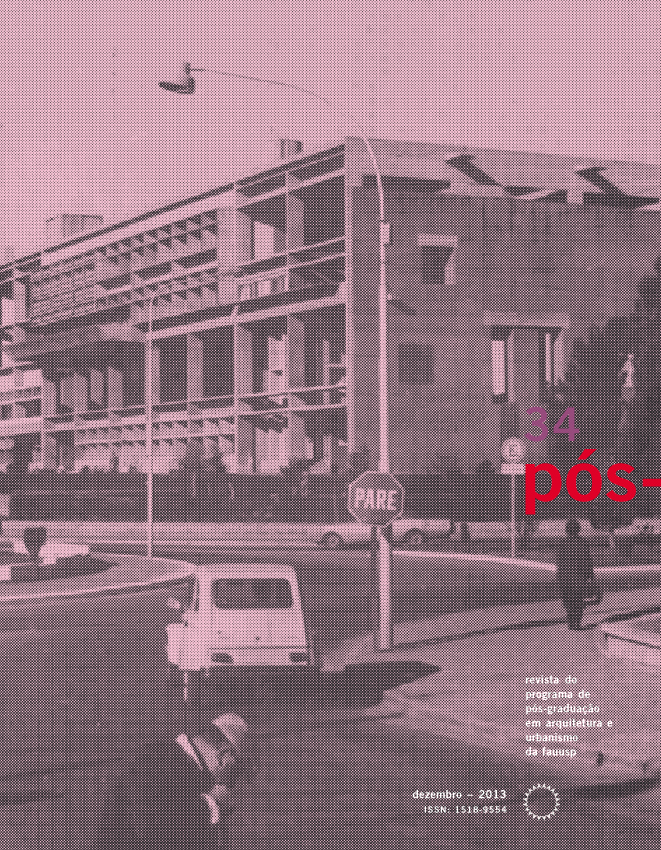História de um lugar moderno: Clorindo Testa e o centro cívico de Santa Rosa, La Pampa
DOI:
https://doi.org/10.11606/issn.2317-2762.v20i34p110-125Palavras-chave:
Arquitetura moderna. Cidade moderna. Centro cívico. Clorindo Testa. Modernidade. Monumentalidade. Lugar. América Latina. Áreas centrais (Argentina).Resumo
Santa Rosa, capital da jovem província de La Pampa, Argentina, foi fundada em 1892, ao término das campanhas militares que exterminaram as populações indígenas e asseguraram o controle republicano sobre os territórios do sul, da região pampiana à Patagônia. Em 1955, a cidade promoveu um concurso público, para a construção do seu Centro Cívico. A tarefa colocada pelo concurso não correspondia a uma simples operação de preenchimento, destinada a renovar o centro urbano propriamente dito, com a elevação de uma nova fachada sobre um dos quatro lados da praça principal. Ao contrário, os competidores deveriam organizar um conjunto de novos edifícios e espaços públicos, sobre um terreno de nove hectares, excêntrico com relação ao core fundacional. Tratava-se de fazer, quase do zero, um pedaço novo de cidade, precisamente no limite entre a cidade existente e o imenso pampa que a circundava. A proposta de Clorindo Testa, vencedora, foi construí-lo como um pedaço de cidade moderna. Situado em meio ao pampa argentino, o Centro Cívico de Santa Rosa tem sido menos examinado que outros importantes edifícios de Clorindo Testa no mesmo período, como o Banco de Londres (1959) ou a Biblioteca Nacional (1962), ambos em Buenos Aires. A Casa de Governo, a Estação Terminal de Ônibus e a praça coberta se constroem antes de 1963. Testa finaliza o Palácio do Legislativo em 1976, e, ainda que em 2006 volte a construir em La Pampa, com a inclusão da pequena Biblioteca do Legislativo, a metade da área originalmente destinada ao Centro Cívico permanece livre. No entanto, como peça viva de um projeto moderno, talvez nunca concluído, instalado no extremo sul, o caso de La Pampa parece colocar questões urbanas relevantes. O artigo explora o caso em dois sentidos complementares. O primeiro focaliza o resultado do primeiro concurso, reconhecendo nele uma contribuição original para as relações entre modernidade, monumento e lugar. O segundo discute a condição inacabada do Centro Cívico como constitutiva da tradição moderna, no sentido intrinsecamente moderno da cidade mesma, como obra que jamais se completa.Downloads
Referências
BANHAM, R. Neoliberty: the italian retreat from modern Architecture. The Architectural Review, n. 747, p. 230-235, 1959.
BREA, A.; DAGNINO, T. Señores arquitectos. Diálogos con Mario Roberto Alvarez y Clorindo Testa. Buenos Aires: Ediciones Ubroc, 1999. 225 p.
CABRAL, C.P.C. Notes on the unfinished modern monument. Clorindo Testa’s Civic Center in Santa Rosa, La Pampa. In: INTERNATIONAL DOCOMOMO CONFERENCE, 10., 2008, Rotterdam. Anais... Rotterdam: IOS Press, Delft University Press, 2008.
CABRAL, C.P.C.; CORADIN, C.S. Clorindo Testa: os projetos para o Centro Cívico de Santa Rosa, La Pampa (1955-2006). In: SEMINÁRIO DOCOMOMO BRASIL, 7., 2007, Porto Alegre. Anais... Porto Alegre: PROPAR-UFRGS, 2007.
CHOAY, F. Alegoria do patrimônio. São Paulo: UNESP, 2001. 282 p.
CUADRA, M.; MARTÍNEZ, A.C. Clorindo Testa, Architect. Rotterdam: NAI Publishers, 2000. 160 p.
PALACIOS, R. G. Genealogía y transformaciones del trazado de Santa Rosa, La Pampa, entre 1881 y 1931. Registros, n. 1, p. 151-162, 2003.
GIEDION, S. et al. In search of a New Monumentality: a symposium by Gregor Paulsson, Henry-Russel Hitchcock, William Holford, Sigfried Giedion, Walter Gropius, Lucio Costa, Alfred Roth. The Architectural Review, n. 621, p. 117-128, 1948.
PURINI, F. La Arquitectura didáctica. Murcia: Colegio Oficial de Aparejadores y Arquitectos Técnicos, 1984. 242 p.
ESTRADA, E. M. Radiografía de La Pampa [1933]. Buenos Aires: Allca Scipione Cultural, 1997. 586 p.
ROWE, C.; KOETTER, F. Ciudad collage. Barcelona: Gustavo Gili, 1981. 182 p.
SOLÀ-MORALES, I. Teorias de la intervención arquitectónica. Santiago: Pontificia Universidad Católica de Chile, 1987. 24 p.
SCHERE, Rolando. Concursos 1826-2006. Buenos Aires: Sociedad Central de Arquitectos, 2008.
SEGRE, R. O realismo mágico na arquitetura argentina. AU, n. 106, p. 61-67, 2003.
TESTA, C. Casa de Gobierno de La Pampa. Summa, Buenos Aires, n. 2, p. 39-49, 1963.
TESTA, C.; LACARRA, H.; ROSSI, F. Centro Cívico de Santa Rosa La Pampa. Ampliación Casa de Gobierno y Ministerios, Palácio de Justicia y Centro Cultural. Summa, Buenos Aires, n. 183/184, p. 106-109, 1983.
VIDLER, A. The architectural uncanny. Cambridge: The MIT Press, 1992. 257 p.
ZAGO, M. La Pampa Argentina. Buenos Aires: Gobierno de La Pampa, 1999. 175 p.
Downloads
Publicado
Edição
Seção
Licença
O detentor dos direitos autorais é o autor do artigo. A revista exige apenas o ineditismo na publicação do artigo. O autor tem do direito de divulgar seu artigo conforme sua conveniência devendo citar a revista.
DIADORIM - Diretório de Políticas Editoriais












